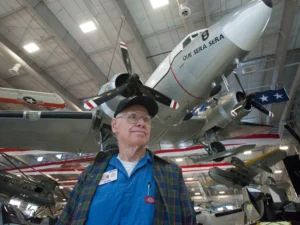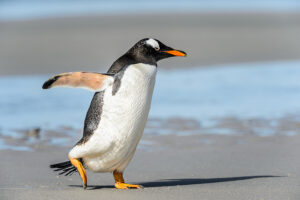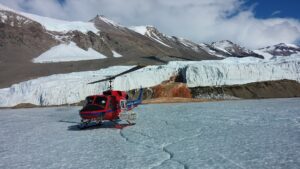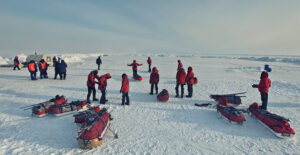This year’s Antarctic summer featured the usual cast of characters: frigid weather, sastrugi, injuries, and self-promotion. But this season also featured a rarity, a new record. And not a marginal record, but the women’s speed record from Hercules Inlet to the South Pole, a record that is regularly attempted and had stood since 2016.
Swede Johanna Davidsson had set a strong time for the 1,130km route, finishing in 38 days and 23 hours. Yet this year, Caroline Cote smashed that time, knocking 5 days from it. Her time of 33 days, 2 hours, and 55 minutes should prove hard to beat.
Now back in Canada, we caught up with Cote to talk about her preparations for the trek, the weather, and the importance of attitude.
How did you build up to this speed record attempt in terms of training and previous expeditions?
Two years ago I started planning, not really knowing if I could go fast enough for the record. One year into my preparations, I started to build up the money for the expedition, and originally I was meant to go last year.
Mainly, I trained in Canada. I’m a trail runner, so I did lots of that for fitness. I tried to improve my skiing — I’m not really a good skier. I joined a Greenland crossing to learn from the Norwegian guiding company and completed a Svalbard expedition last year. But I still wasn’t sure about pulling a sled for so many days!
Financing
You mention financing the expedition. How did you go about this?
It was super stressful and took a lot of energy. At first, I didn’t know it was so expensive. Fortunately, in Quebec, everyone in adventure knows each other. Good friends in the community with good contacts helped me to raise funds. I put in a lot of my own money too, and my parents helped.
I was really worried about whether I’d need an evacuation and how much that would have cost.

Cote out on the ice. Photo: Caroline Cote
Clearly, your preparations worked, but did anything in Antarctica surprise you? Was there anything that you feel your build-up couldn’t properly prepare you for?
In northern Canada, I prepared as best I could for the sastrugi, but they were still a struggle.
My main concern was the wind. I feared the Antarctic weather, so I was prepared for that. Svalbard was good preparation for the wind. Lars [Ebbesen – Cote’s weather expert, an experienced Antarctic guide] was really good. He chose his words carefully, encouraging me and always saying that there would be less wind ahead.
Conditions always ‘unprecedented’
Weather is always a controversial topic for Antarctica. The ones who struggle often blame it on unprecedented conditions. What is your understanding of conditions this year compared to most years?
I had been to Antarctica in 2014, on the peninsula. It was the end of the summer season and the weather was really bad. I was very young and felt terrible. I thought it might be the same [for this expedition] but you can’t compare the weather on the Antarctic peninsula with the continental weather.
Apparently, there were more sastrugi this year, but I was scared about sastrugi so was well prepared for these [thanks to her training in northern Canada]. A lot of wind was the main challenge.

Photo: Caroline Cote
I was happy that many days were quite flat. The worst part was the beginning of the journey when I was worried about losing days in the tent. There was an extremely strong wind and it was very cold. My concern was that it might extend to two or three days with zero kilometers covered. But in the end, I only spent one morning in the tent. By the afternoon, conditions improved and I could keep moving. It was the only time with a lot of wind like that. I was really lucky.
Sticky snow?
How about “sticky” snow?
I’m not sure, I don’t think I encountered sticky snow. I tried to be positive about what was in front of me. Whether conditions are good or bad, you have to do the kilometers. I like all the snow!
I’m glad you mentioned positivity. That seemed like a theme throughout your expedition. Your daily updates always sounded very upbeat. Can you tell me about your mindset for this challenge?
I wanted to do my best and think positively for my supporters. They all made time for me. I didn’t feel sorry for myself and so I was able to give everything I had.
But it wasn’t always easy. Mornings were the time I felt most alone, these were the most difficult. Sleeping well is very important for energy. Eat, sleep, ski, repeat. I was crying sometimes because I didn’t sleep well, or I was low on energy. But Lars and my team advised that I should “cry and go,” let it out, and continue.
I thought of it like trail running. It is training, it is what I like to do! It’s fun at the end of the day and I felt good.

End of the trail. Photo: Caroline Cote
Few gear problems
Any big problems: frostbite, injuries, broken equipment?
I didn’t talk about these much at the time but I had some problems. On day five, my ski binding unglued. I had to remove my skis and ended up stopping a bit earlier in the day. I removed the old glue, glued it again with my repair kit, and it thankfully held.
My solar panels also suffered from humidity and had to be repaired. Again, this was very early on, on day five or six. All my other gear worked well, which was fortunate as I didn’t have spares. I only had a single set of skis to save weight.
Only small parts of my body were affected by the cold, a little bit of frostnip on a toe. My recovery should take about two weeks, I think. My stomach is still weird from eating so much and so differently. But this is part of the process of going out there and giving everything you have.

In the polar regions, looking after your feet is a must. Photo: Caroline Cote
Can you talk me through arriving at the Pole after 33 days alone on the ice? I believe your husband and Hannah McKeand [a former speed record holder for the same route] met you as you arrived.
It was something out of my mind. I thought of the South Pole as the flags and pole, but it was so different. Lots of people were there.
I was amazed that Hannah was there, she woke up at night to come and see me, and this meant a lot. She invited me on a small tour around the base. There was lots of emotion, Hannah and Johanna [Davidsson] were the people that inspired me to go and do this. They showed me that it was possible.
Vince [Colliard – Cote’s husband] was there, it’s crazy how life works. Not many people get a chance to meet their partner when they finish. He just happened to be guiding a last-degree trip and the timing matched up!

Caroline Cote and Vincent Colliard at the South Pole. Photo: Caroline Cote
Beyond the horizon
And finally, what’s next? Do you have any plans to return to Antarctica?
I’ve thought about it. When I had just finished, I was bored and tired, I felt at my worst. I was almost in a negative space – I never wanted to do anything again! But it’s different after a night’s sleep and I was ready for another challenge.
My first goal is to help my partner [Colliard] to do some expeditions. To help with food, preparations, etc., just as he did for me. After that, I’m not sure yet, perhaps I’ll return to Antarctica to guide.






